Growing up in a Cuban family means no one knows the measurements of any recipe. True story! Just like I did with my arroz con pollo, I had to watch Mami make this ropa vieja recipe to figure out the exact measurements.
See, Cuban kitchen legends, like my mom, don’t know any measurements of any Cuban recipe. They’ve been cooking with un poquito (a little bit) as their measurement of choice for years. She does the same thing with her carne con papas and her vaca frita recipe. It’s incredible how her cooking manages to always taste the same every time!
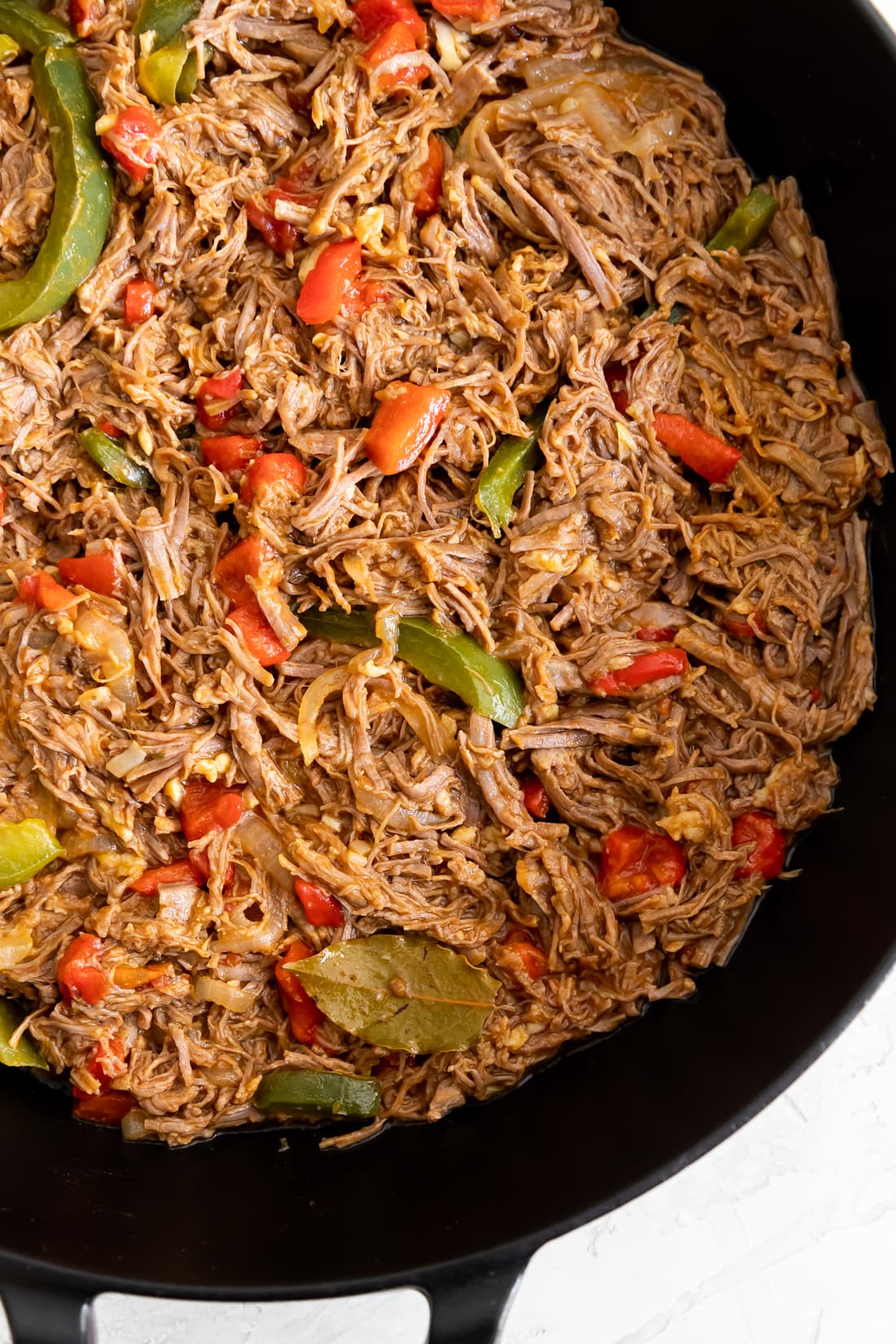
What is Ropa Vieja?
Ropa vieja, which translates to “old clothes” in Spanish, is a traditional Cuban dish featuring tender shredded beef simmered in a rich tomato-based sauce with Cuban sofrito and aromatic spices. Kinda like my Cuban picadillo. YUM!
The name “ropa vieja” is based on the appearance of the shredded beef, which resembles a pile of old clothes. I assure you this dish does not look or smell like old clothes. Ha!
This hearty and flavorful dish is a staple of Cuban cuisine. While ropa vieja shares some qualities of a stew, it’s not typically classified as one. It’s a distinct dish in its own right often described as a shredded beef dish with a rich, saucy consistency.
When you’re done with this recipe, make another one of my Cuban dinner recipes!
Best cut of beef for Ropa Vieja
When it comes to making ropa vieja, you want a cut of beef that can handle some serious slow-cooking action to get that melt-in-your-mouth tenderness.
Flank steak is my top pick for ropa vieja. It’s a tougher cut that, when simmered low and slow, breaks down beautifully, soaking up all those delicious flavors from the tomato-based sauce. In a pinch, you can use brisket or beef chuck roast (pot roast).
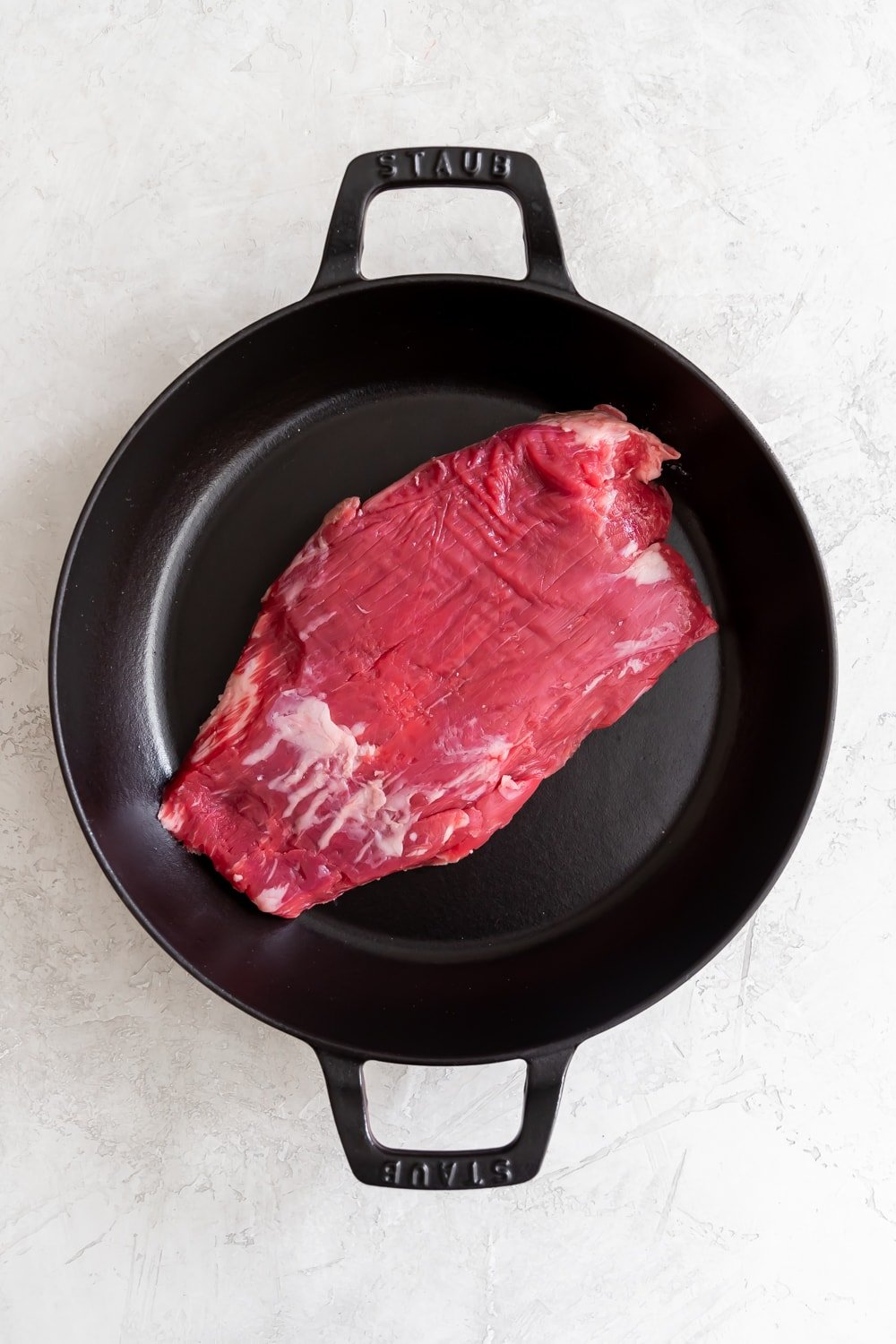
When is Ropa Vieja eaten?
In Cuban cuisine, ropa vieja is commonly eaten for dinner as a hearty main course. It’s also a popular choice for special occasions and celebrations, such as holidays, birthdays, and family gatherings (Sundays for us!). Overall though, ropa vieja is a versatile dish that can be enjoyed anytime, anywhere.
Difference between Ropa Vieja and Vaca Frita
I get this question a lot because of the similarities in both recipes. Both ropa vieja and vaca frita are close cousins. While both dishes showcase the deliciousness of beef in Cuban cuisine, Ropa Vieja is all about slow-cooked comfort, while Vaca Frita brings a crispy, flavorful pan-fried twist to the table.
Ropa Vieja is a stew-like dish where the beef practically falls apart with each forkful. On the other hand, Vaca Frita, which translates to “fried cow” or “crispy beef,” takes a different approach. Instead of simmering, the beef is typically marinated with mojo marinade, then pan-fried until crispy.
5 star review
“I picked your recipe because it seemed the most authentic. It did not disappoint. As a fellow Cuban (descent), it was delicious. Thank you.”
—Beatriz
Ingredients You’ll Need
Aside from the flank steak, you need:
Sofrito: The base of the sauce, known as sofrito, is crucial for authentic flavor. It typically includes onions, bell peppers, garlic, and tomatoes, all sautéed together until soft and fragrant. This aromatic mixture forms the foundation of the dish, infusing every bite with depth and complexity.
Tomato Sauce: A rich tomato sauce is a key component of authentic ropa vieja. It adds a sweet-tangy flavor and vibrant color to the dish, complementing the savory beef and aromatic sofrito.
Seasonings: Authentic ropa vieja is seasoned with a blend of spices that may include cumin, oregano, bay leaves, and black pepper. These spices add layers of flavor and enhance the overall complexity of the dish.
Recommended For This Recipe
Dutch Oven
I use a 6-quart Dutch Oven often when I’m making soups and stews and even when I’m cooking other recipes that require longer hours of cooking.
Instructions
Ok, I know at first glance it seems like this recipe appears super tedious to make however I can assure you most of the recipe is hands-off!
Here’s how you can make ropa vieja Cuban-style at home.
Cooking The Meat
In a Dutch oven or large pot, add the meat with water and salt. Cook at medium-low until the meat is tender, about 2 hours. (In a pressure cooker, this takes about 40 minutes). Transfer the meat to a plate. Using two forks, shred the beef. Set aside.
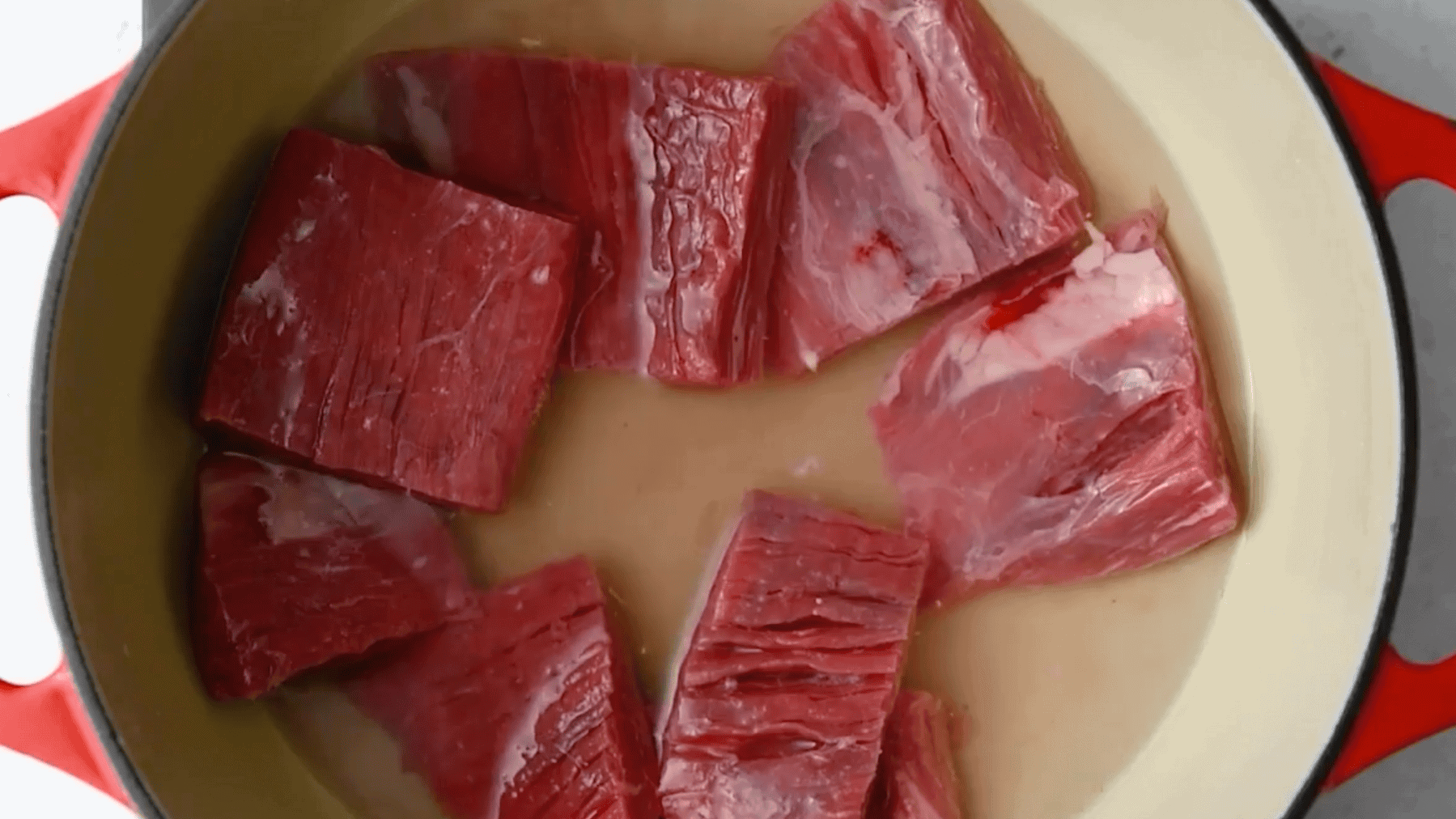
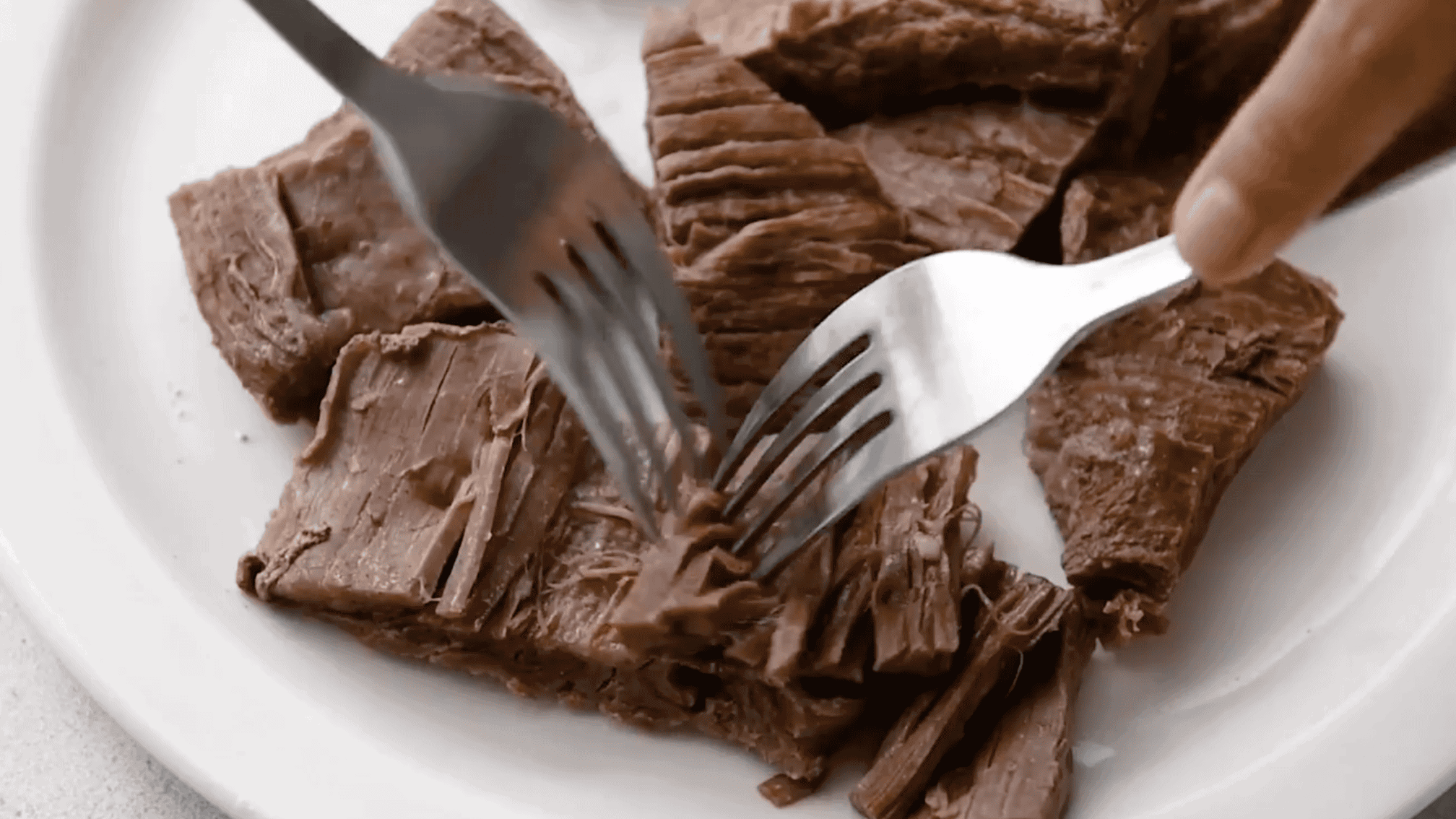
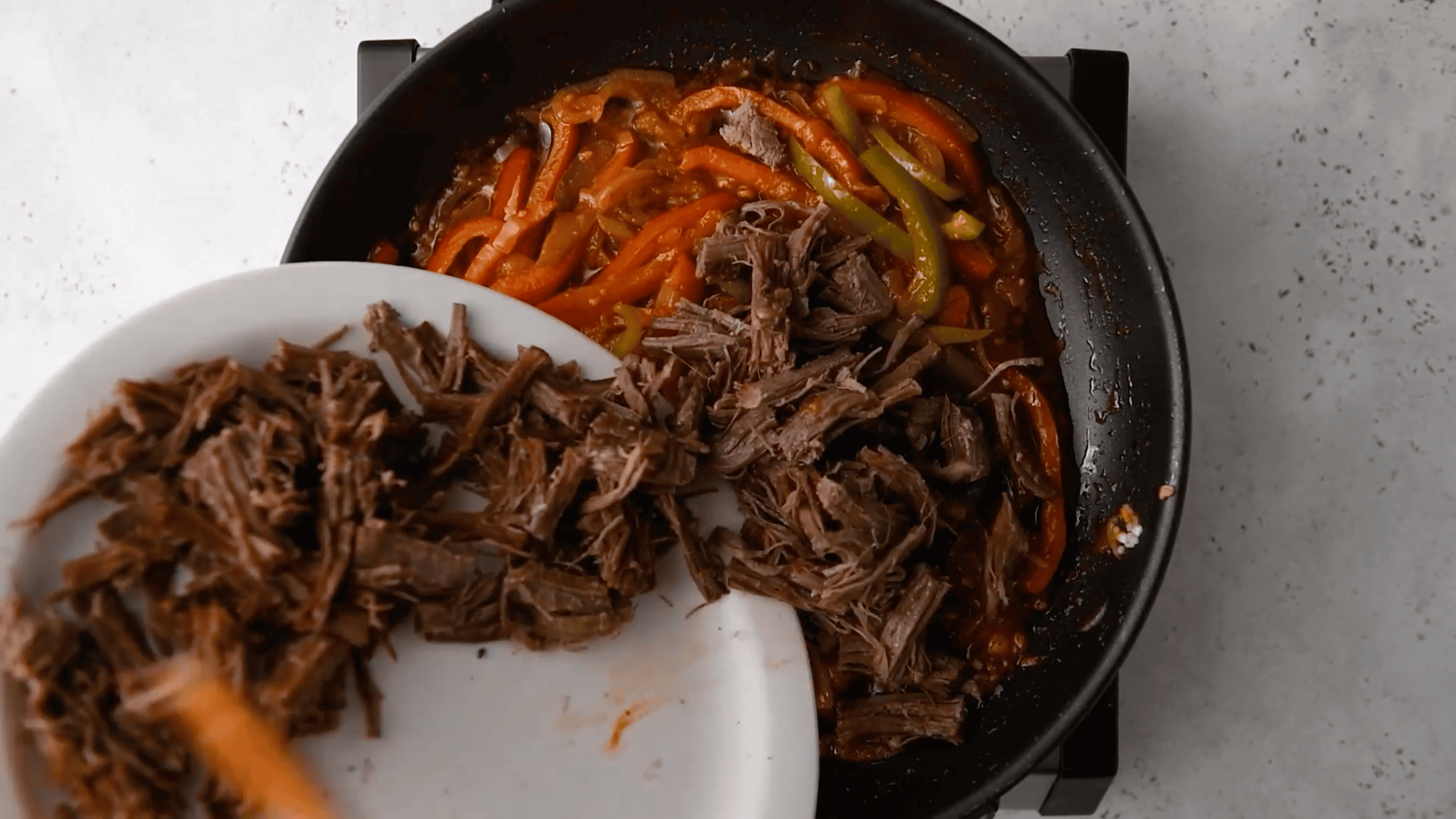
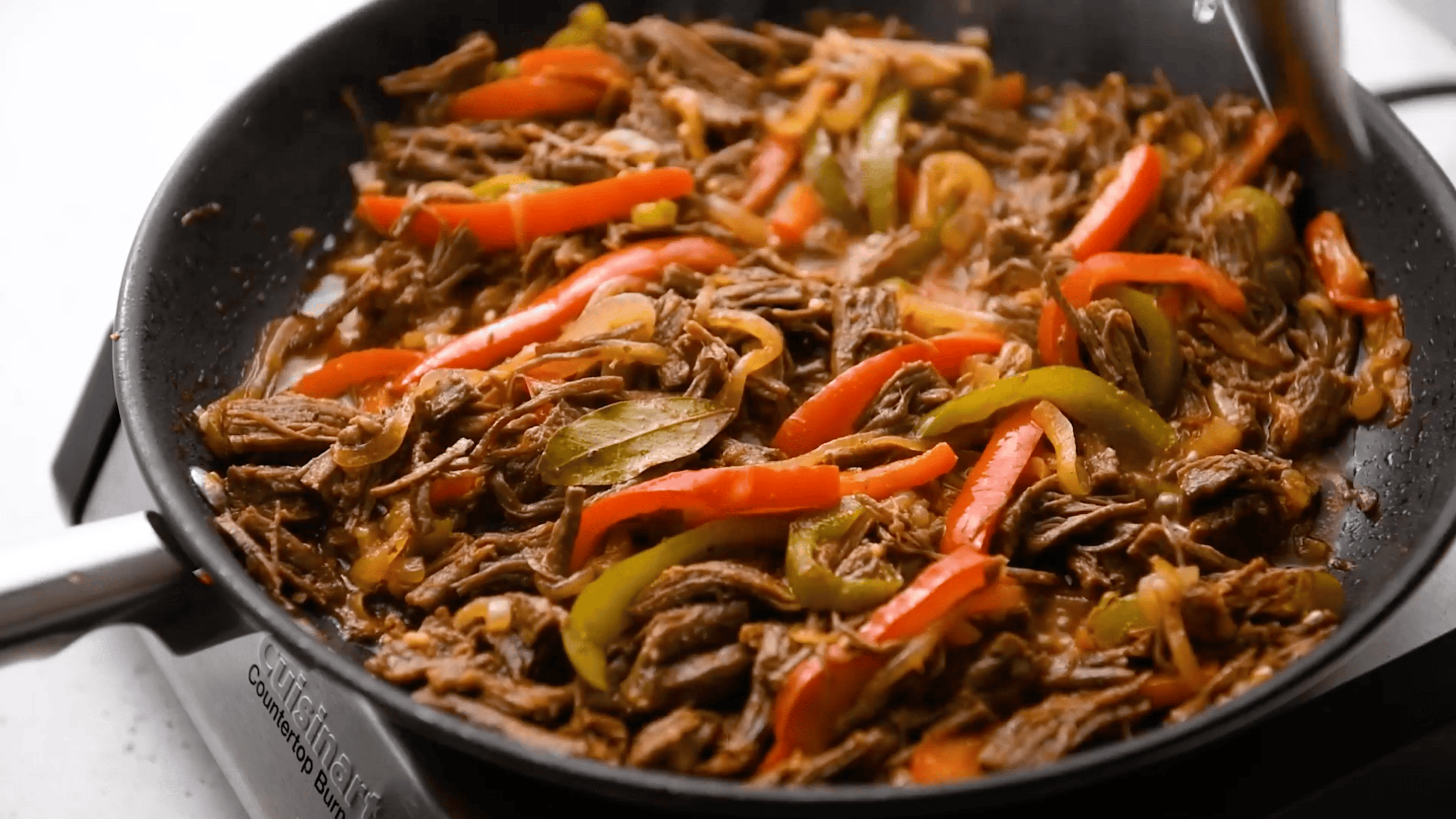
Making The Ropa Vieja On The Stove
In a large skillet, heat olive oil at medium heat. Add green pepper, onion, and pimientos. Sauté for 1-2 minutes. Add garlic and sauté for 30 seconds.
Add tomato sauce, vino seco (dry cooking wine), cumin, oregano, bay leaf, salt, and pepper. Cook for 15-20 minutes, at medium heat, stirring occasionally.
Add the shredded beef to the skillet. Stir to combine with the tomato-based sauce. Cover and cook on LOW for about 10-15 minutes, stirring occasionally, without letting it dry out. Taste and adjust seasoning with salt and pepper if needed. Enjoy!
Looking for another authentic Cuban dinner recipe? Make my classic Arroz Imperial!
Alternative Ways To Make Ropa Vieja
While I personally believe the stovetop version is the best method because the result is perfect, you can make ropa vieja in other ways.
- Slow Cooker. Transfer the shredded meat to the slow cooker along with the sauce ingredients. Cook on low for 6-8 hours or on high for 3-4 hours until the beef is tender and easily shreds apart.
- Instant Pot. Add the shredded meat and sauce ingredients to the instant pot. Cook on high for about 60-90 minutes, depending on the size of the meat.
- Pressure Cooker: Add the shredded meat and sauce ingredients to the pressure cooker. Cook for about 30-45 minutes.
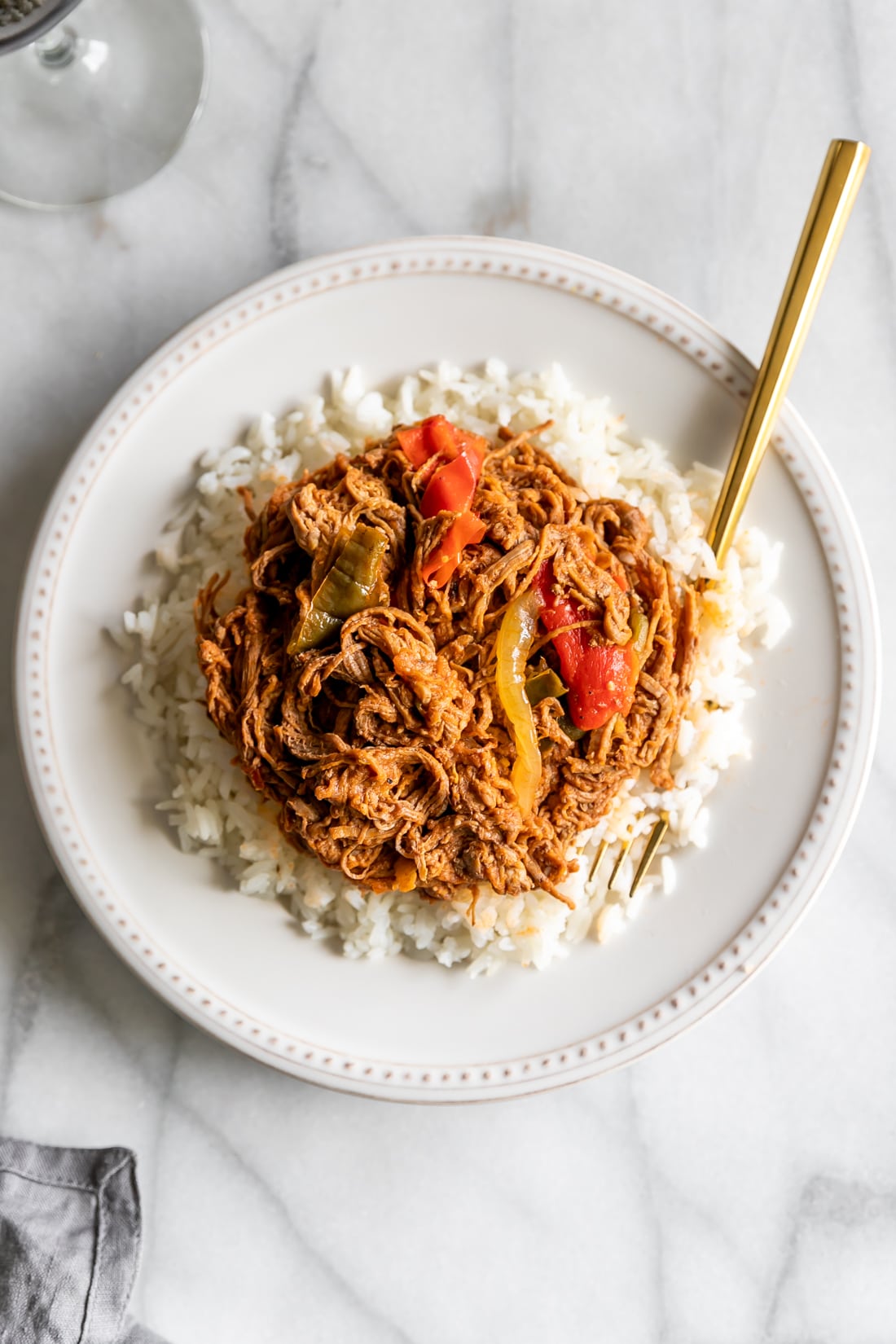
Serving Suggestions
Here are some traditional accompaniments that pair well with this classic Cuban dish:
- Fluffy White Rice
- Tostones (Twice-Fried Plantains)
- Sweet Plantains (Maduros)
- Ensalada de Aguacate (Avocado Onion Salad)
Storage Tips
Store leftovers in an airtight container and place it in the fridge for up to 3-4 days. For longer storage, freeze in airtight containers or freezer bags for up to 3 months. Thaw overnight in the refrigerator before reheating.
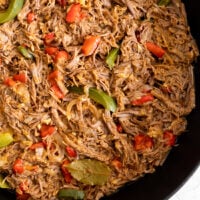
Authentic Cuban Ropa Vieja (Shredded Beef Recipe)
Ingredients
- 2 lbs flank steak cut into pieces
- Water (enough to cover the meat in the pot)
- 1 teaspoon salt
- 1/3 cup olive oil
- 1 medium yellow onion diced
- 1 medium green bell pepper sliced lengthwise
- 7 ounces whole red pimientos sliced lengthwise
- 4 cloves garlic minced
- 8 ounces tomato sauce
- 1/2 cup vino seco (dry cooking wine)
- 1 teaspoon ground cumin
- 1 teaspoon dried oregano
- 1 bay leaf
- Salt + pepper to taste
Instructions
Cooking The Meat
- In a Dutch oven or large pot, add the meat with water and salt. Cook at medium-low until the meat is tender, about 2 hours. (In a pressure cooker, this takes about 40 minutes). Transfer the meat to a plate. Using two forks, shred the beef. Set aside.
Making The Ropa Vieja
- In a large skillet, heat olive oil at medium heat. Add green pepper, onion, and pimientos. Sauté for 1-2 minutes. Add garlic and sauté for 30 seconds.
- Add tomato sauce, vino seco (dry cooking wine), cumin, oregano, bay leaf, salt, and pepper. Cook for 15 minutes, at medium heat, stirring occasionally.
- Add the shredded beef to the skillet. Stir to combine with the tomato-based sauce. Cover and cook on LOW for about 10-15 minutes, stirring occasionally, without letting it dry out. Taste and adjust seasoning with salt and pepper if needed. Enjoy!
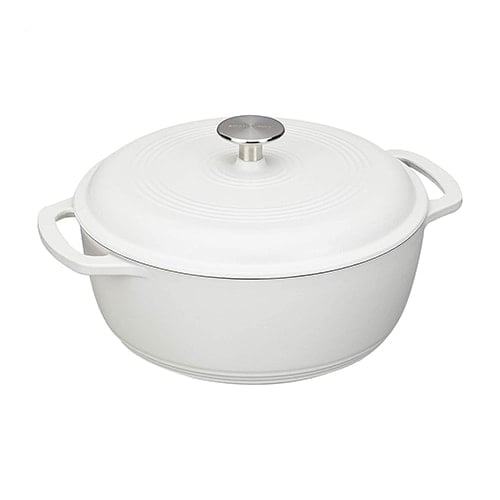


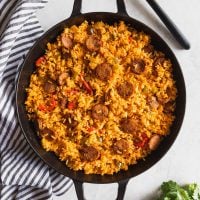






Marianela says
I love ropa vieja, my abuela use to make it and this is the closest to her cooking. So good 😋
Thank you I shared it with my American friend and she is in love with your site now. Besitos
Jamie Silva says
Thank you for spreading the word! 🙏🏼
Larry says
I grew up in Tampa in the early 1960s amongst Cubanos and moved to Tennessee in my later years. Not only did I miss the Cubano sandwich and the other great Cuban food but one that I think I miss the most was the crab croquettes and the great Cuban food from the Columbian Restaurant. Your recipes bring back old memories! Keep it up.
Randy says
Very tasty! I’m from SW Fl, but moved out in the late 80’s. Miss my Cuban food. Made this with some plantanos and rice.
Renee says
Authentic and so delicious and super easy. I did double the sauce as i found it needed some after i added the beef back.
Scott says
Hi Jamie! I am writing down the recipe for the Ropa Vieja and the cooking instructions, it states to add the red pepper, but there is not a red pepper ingredient (unless you’re meaning the pimento). Can you clarify for me?
Jamie Silva says
Yep! Pimiento is roasted red pepper :)
Christy says
Hi! I tried your Ropa Vieja recipe last night and it was delicious. We loved it. Thank you for sharing this recipe with us.
Jamie Silva says
You’re so welcome, Christy! So happy you loved it!
Darell Delaney says
Delicious
exactly like my Mom and Grandmother taught me. says
I like your recipes very much.
Beatriz says
I picked your recipe because it seemed the most authentic.
It did not disappoint. As a fellow Cuban (descent), it was delicious.
Thank you.
Haydee says
This is the authentic, truly Cuban recipe and very easily explained.
Jamie Silva says
Happy you loved it, Haydee!
Carlos Cordova says
Very well explained, I will try it as soon as I can. Many thanks for your time and your recipe.
Michael Gonzalez says
Great recipe , simple and with lots of flavor !
Jamie Silva says
So happy you enjoyed it, Michael!
Manny says
This was such a easy recipe to prepare! There is so much flavor in this dish. I tweaked the recipe a little adding some diced potatoes and chard after sautéing with red wine. I read red wine is better than cooking wine in that there are unneeded sweeteners in most “cooking wine”. I used brown rice as a side. I also added a little more tomato sauce since I was worried it would get to dry. Will makes again.
Lily says
Cooking it for the 2nd time now, delicioussss!! Thanks so much, this is a great authentic recipe. Closest to the most authentic Cuban restaurants in Chicago that I grew up going to. Full of flavor! Thanks again! My kids also love it! 😊
Alyssa says
My husband is vegetarian and doesn’t get to experience enough Cuban food because of it. I will be trying this with jackfruit and I can’t wait!! Thank you for creating these recipes so I can share my culture with my husband and his family as well.
Jamie Silva says
That sounds incredible, Alyssa! Please report back on how jackfruit ropa vieja tastes… I’m so curious. :)
Claudia says
Already making this every week as a family staple but did learn a thing or two from your eceipe ! Just like all your meals…this one too is delicious!!
Jamie Silva says
Thank you!! :)
Mikaela says
Made this for dinner tonight and it was fantastic!!! Took me right back to my time in Havana. I cooked the steak in the instant pot for 30 mins on high, 20 min natural release and it shredded easily. Loved it!
Jamie Silva says
YAY! So happy you loved it, Mikaela!